This is a short excursion into my breadmaking brain. Wanting to bake but lacking any prep other than some discard, this is what I came up with. I captured my process here as it happened from ideation (a scrap piece of paper with baker’s math) to finished product. The recipe and tips are below, but if you want a recipe with a little more direction (process shots and shaping videos), here are two good ones: Good Baguette, Summer Baguette.
Thanks for reading! Martin
Last Saturday night I didn’t make a preferment. I knew that I wanted to make bread the next day but after a full week of baking chores, deciding what to bake, or even writing a formula felt insurmountable. Rather than doing any prep, I went to bed.
When I got up Sunday morning—recharged, caffeinated, counting down the remaining minutes of my weekend—my breadmaking hunger returned with a vengeance. Hey, I’m a baker. 🤷
But, no preferment. While I could have made pane siciliano or many other things that don’t require one, I kept looking. And here is a true confession. During the week my starter maintenance got away from me. I had fed it, but after that it sat on the counter for an uncounted stretch of days.
After I located the container, I braced a little, expecting to open it and find some pink-hued, funky mess. To my surprise, it didn’t look as bad as I feared, partially due to the extreme cold here. Yes, it was completely thin, runny, and flat, but not yet separated.
Hmmmm, I thought. Maybe I’ll use it and add a little yeast to boost the lackluster activity. I tasted it. Bright, piquant, not bad at all. I might be in business.
The feed I had done earlier in the week included some extra for a video shoot in the studio (coming soon, an intermediate sourdough on-demand course for KABC) so, I had more starter than normal.
Measuring it, the amount was 222g. What can I make with 222g of unhealthy, unfed starter other than crackers, scones, puff pastry, or pie crust? Before I answer that, note that I wanted bread, and I needed it to be done in one day. Also, when I looked at my schedule, I only had time for a couple hours of bulk, an hour or so for final rise, and a bake of about 30 to 45 minutes.
So I decided to make baguettes. Arguably the most finicky, difficult thing possible. Why not? I grabbed a scrap piece of paper and wrote down some numbers for the yet-to-be-christened discard baguette.
The first consideration: What is my batch size? If each baguette weighs 333 grams, the total will be roughly one kilo. That scale weight makes a large home baguette but with a few assumptions about activity and strength, I opted for a slightly larger scale weight.
My next consideration related to dough percentages. I wanted a mostly all-purpose baguette with a little whole grain for flavor. In baker’s math, 95% all-purpose and 5% whole wheat should do. For hydration, I went with 80%. It’s on the high side but I wanted a nice, moderately open crumb. (Note: If you make this, I think you should lower this slightly, down to 75%, for easier handling.)
I honestly wasn’t sure what the impact of the old starter would be. Much of the functional strength had been diminished or eliminated through enzymatic activity and the breakdown of proteins, but acid can also have a firming influence on dough. Lots of questions. As the French bakers say, “la verité sorts du four.” Or, the proof (truth) comes out of the oven.
The other thing in the mix was that in order to hit my timings and get the delicate crumb and crust that I value in a baguette, I wanted a little yeast. (I’ll say it again here, yeast is just a tool. Don’t be too uptight about using it. This is still a sourdough baguette, IMO.) So I add a little, 1/3rd of 1% in baker’s math (.3%).
Here are the total dough percentages (182.3%).
All-purpose flour, 95%
Whole wheat flour, 5%
Water, 80%
Salt, 2%
Yeast, instant, .3%
What about the prefermented flour?
Before I get to the starter numbers, I divide the batch size (1,000g) by the total dough percentage (182.3%) for a total flour amount of 549g. Of that, I want 5% whole wheat. So, the final flour numbers are 522g AP, and 27g WW. With the total flour number I can do the math for my other amounts. (Note that there is a little rounding in the numbers below.)
All-purpose, 522g
Whole wheat, 27g
Water, 439g
Salt, 11g (2 t)
Yeast, instant, 1.6g (½ t)
Now I need to subtract my old starter (which is fed equal parts flour and water). I have 222 grams. I’m hoping that the math comes out, putting me between 15 and 20% prefermented flour. I should also save a small drop to feed.
Doing the math, 549 x 20% = 110. Double that for a total of 220g, leaving me 2g for a build. Perfect.
Subtracting my 110g of flour and 110g of water from the total numbers I have my final mix amounts.
I’ll put shaping videos over on Instagram in addition to the ones that are in the Summer Baguette newsletter. If you’re looking for a more detailed recipe, these are both great: Good Baguette, Summer Baguette.
All-purpose, 412g
Whole wheat, 27g
Water, 329g (I recommend that if you make this for the first time, reduce the water to 75%, changing this number to about 302g. This also means that the dough pieces will weigh about 325g.)
Salt, 11g (2 t)
Yeast, instant, 1.6g (½ t)
Old starter, 220g (You could use healthy levain. Mix 105g of AP and 105 of water with 10g of culture. Set to rise overnight or for roughly 8 to 12 hours before mixing.)
Time to mix.
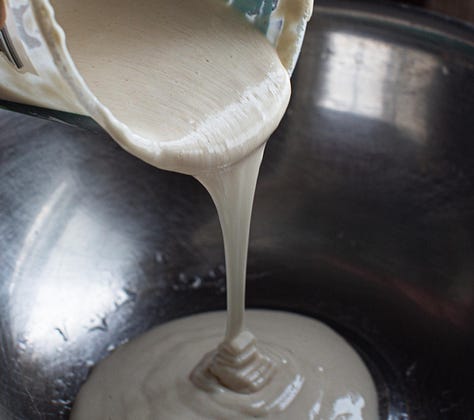

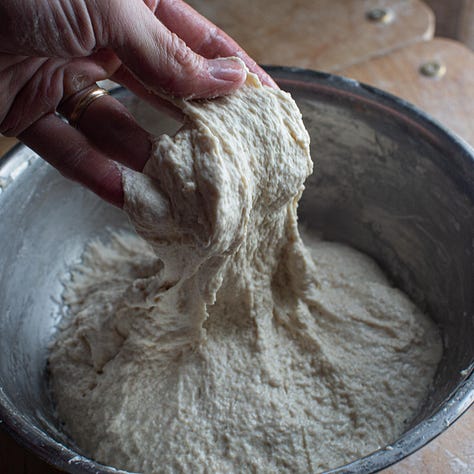
I dispersed the culture into lukewarm water, added the flours, salt, and yeast, and stirred to combine briefly then switched to a wet hand to fold briefly in the bowl. The dough was soft. Maybe a little softer than I wanted.
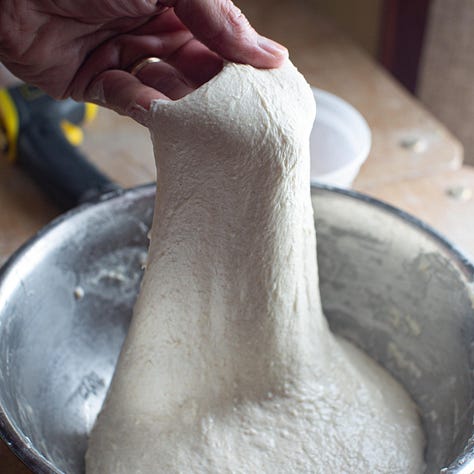

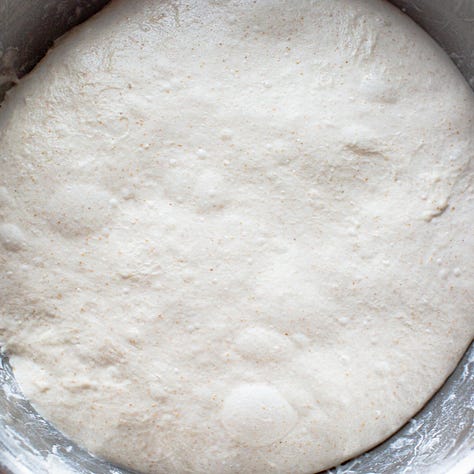
I folded four times over the course of the first hour. With each touch it gained strength and elasticity, transforming from weak and slack to beautifully stretchy—a joy to handle, actually.
After the fourth fold I left it for an hour, untouched.

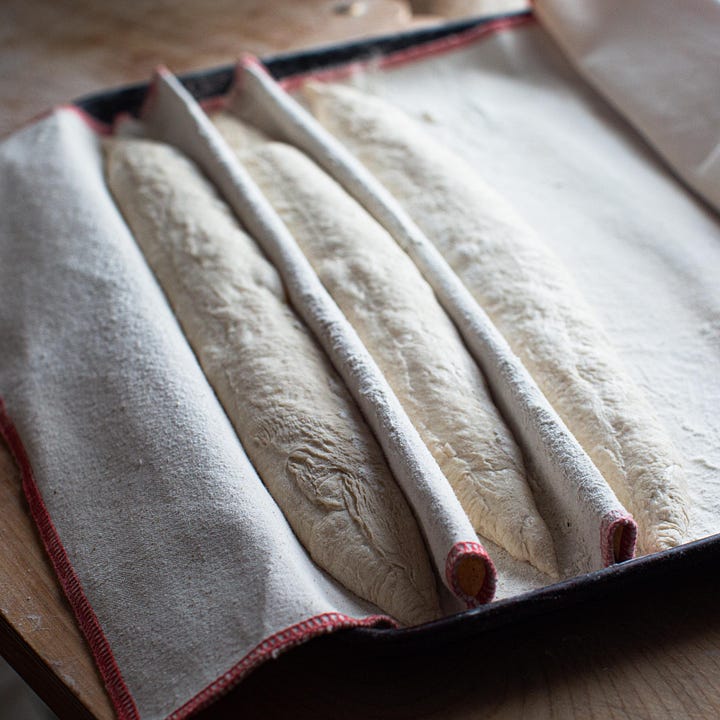
I divided and preshaped into tubes and rested for 15 minutes.
I shaped and placed them seam-side-up on a floured couche and turned on the oven to 500°F with my steaming system in place.
After 40 minutes of rise they were happy. I turned them out, seam-side-down, onto parchment and set them in the fridge for 10 minutes in order to skin, slightly (for easier scoring).
I scored, loaded, and reduced the oven to 475°F, removing them once they were fully golden brown and firm, about 25 minutes in my oven.
But was I happy? Cutting them open, I have to say that the crumb was fine, maybe even good. They opened well and the timings were spot on for this quality of starter and the pinch of yeast. The flavor was excellent, barely sour but also quite malty with a great balance of “mineral” or what I sometimes call a “flinty” quality. As far as detractions, the edge of the loaf where it transitioned from the hearth to the side wall was just a little too sharp. What I mean by that is that they lacked a little strength, they were *slightly* flat. To fix the side wall, giving it a more rounded aspect as it transitions from bottom to side, I might drop a fold and reduce the water by 5%. But that’s a test for another day. Happy baking.
Martin

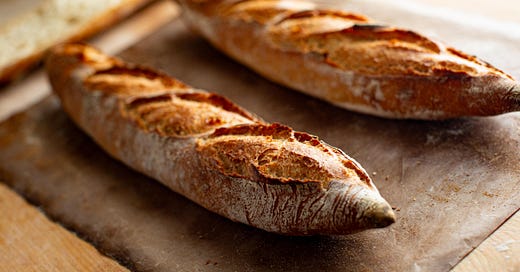


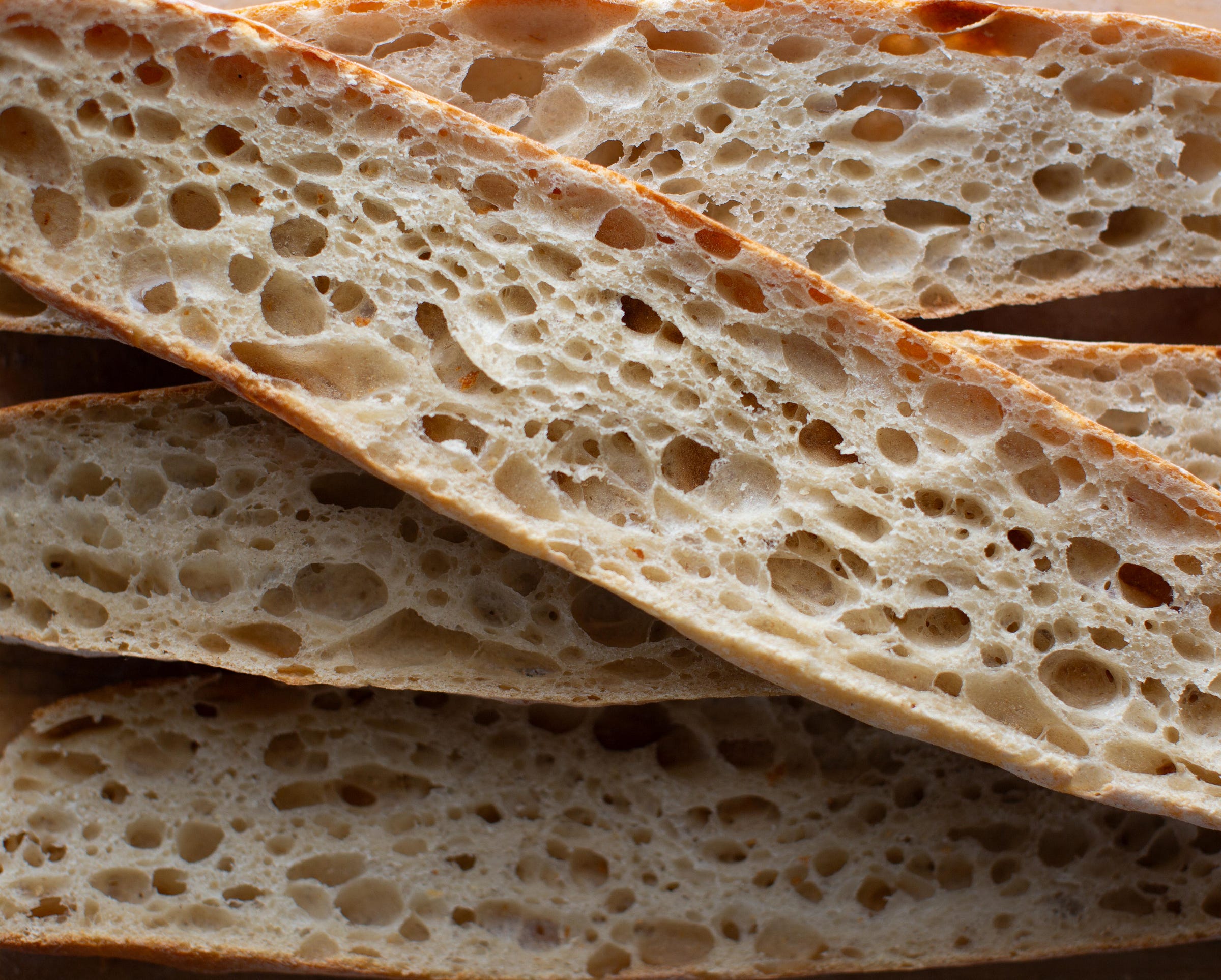

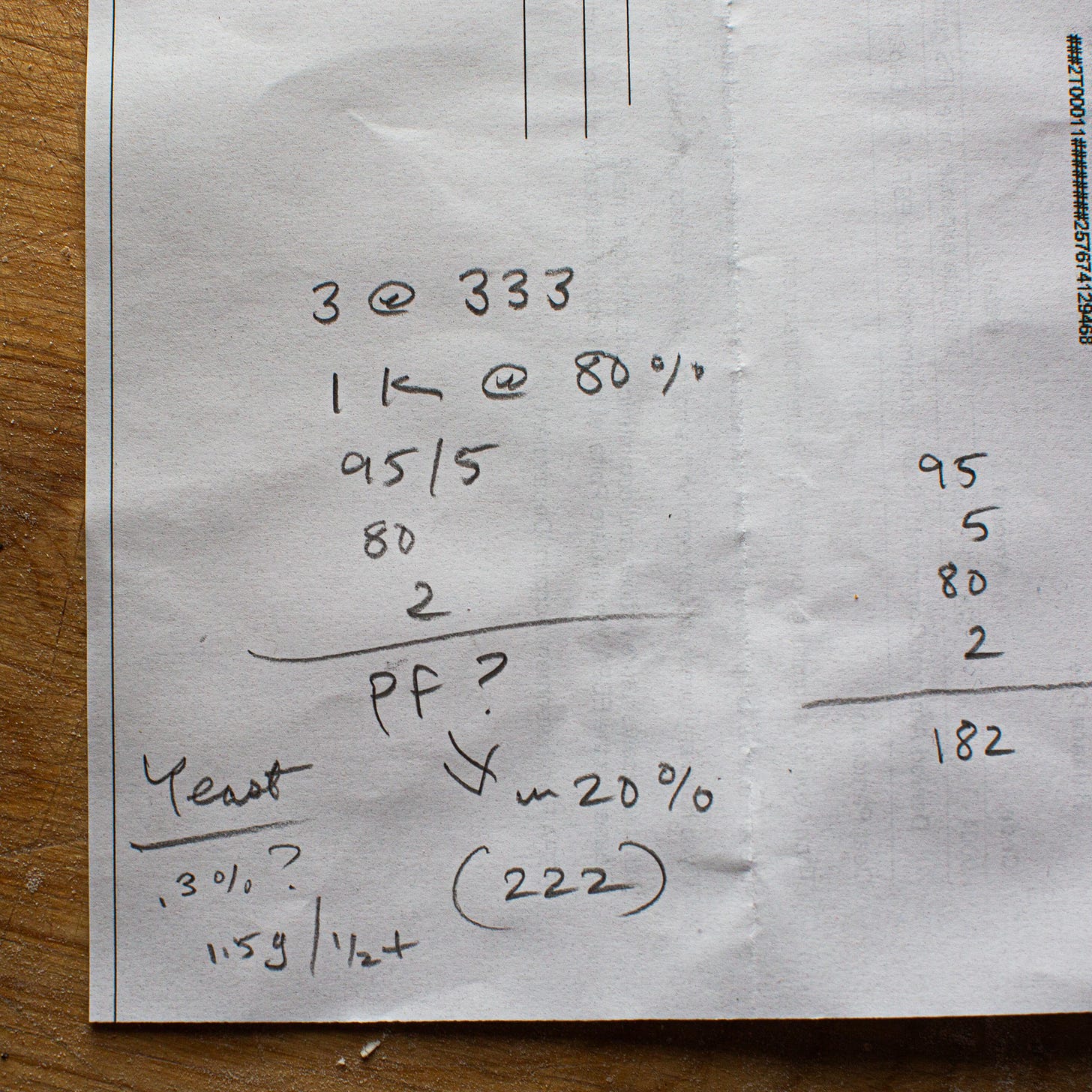
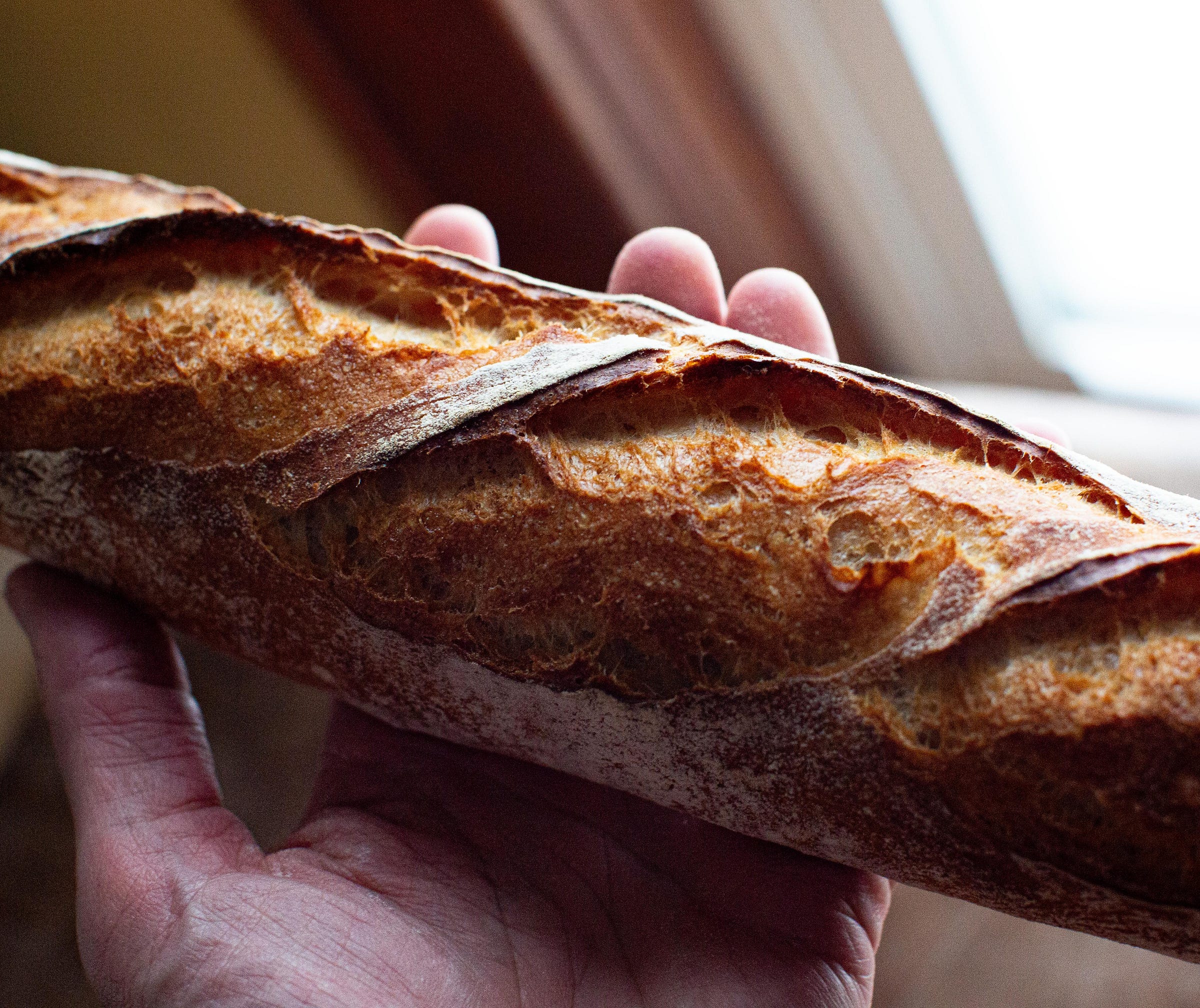
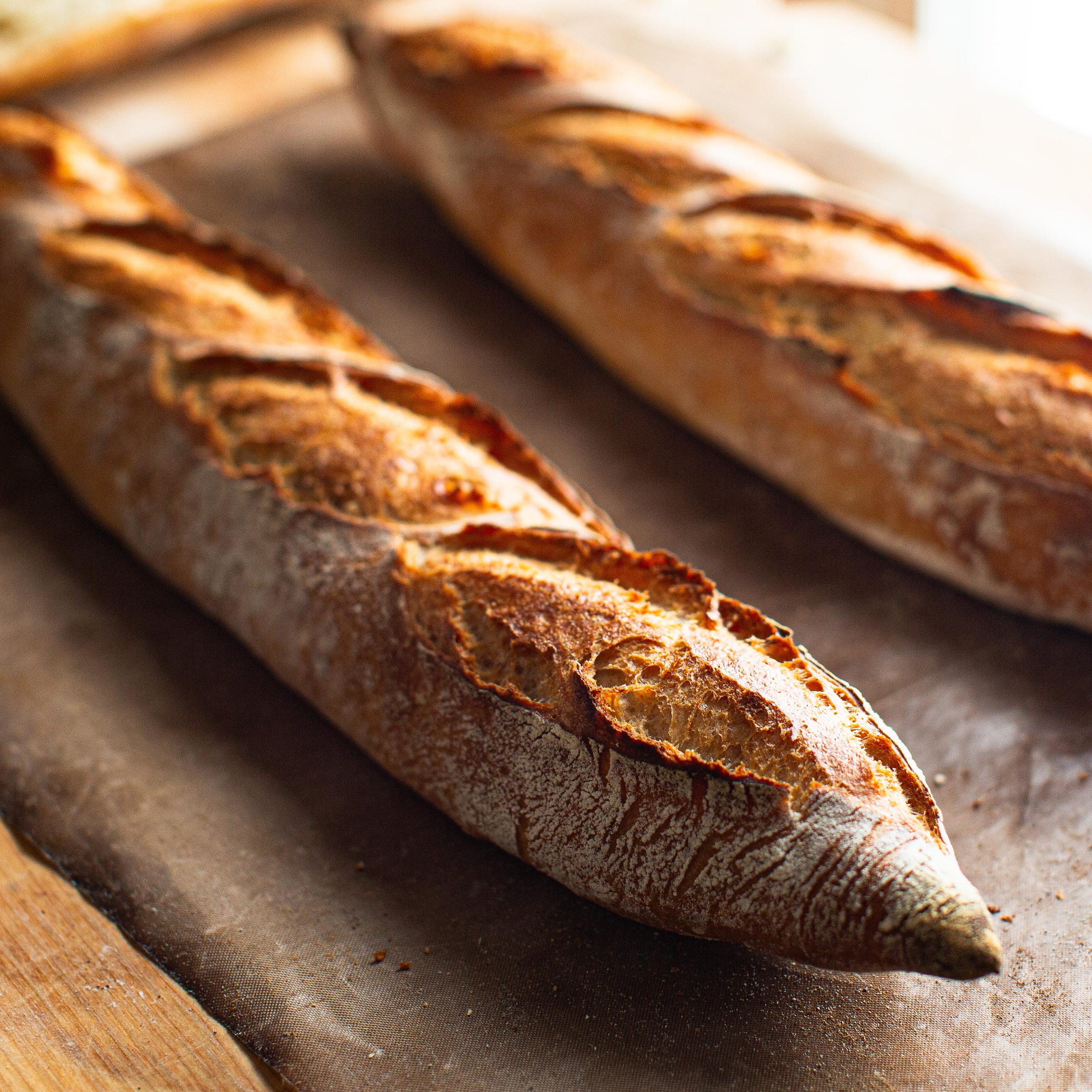
Mine are fresh out of the oven now, popping and crackling happily. Not quite as lovely as yours, but I think they'll be perfect to share with friends at dinner this evening--a gentle, easy bake for a dreary day! Thanks for sharing!
Last night I baked my first ever baguette. I halved the recipe to make just one, as I didn’t have too much discard. Although the crust resembled a baguette-shaped ciabatta, it was absolutely delicious. I even made a brilliant sandwich using some leftover fried chicken tenders from the previous night, along with pickled red onions, cheese, homemade ranch, and a touch of salad.
Thank you for all your hard work – my bread-baking skills and confidence have grown immensely since I started following you. Even as a confident home cook, I found nothing more humbling than bread baking. You’re a fantastic teacher, and your tips and tricks have been exactly what I was looking for. In fact, my wife is on a first-name basis with you; whenever I mention Martin in relation to baking, she knows exactly who I mean – and she thoroughly enjoys my bread endeavours.
Thanks for everything. Much love from an Irishman in London. ☘️